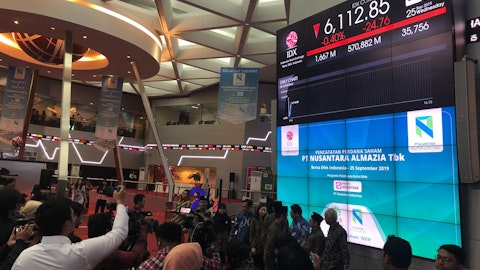Raviv Zoller: All right. Thanks, Ben. In terms of what we’re seeing in Growing Solutions, de-stocking is materially over. And what that means is that we’re going to see normalized margin, which is more like 2021 margin, going into 2023; we’re already growing volume. We grew volume in Q3, even versus last year. So we expect growth of volume and better margin given higher prices and no need for de-stocking. In Q3, we came in actually a little lower on EBITDA than we expected, and I think we’ll see the same in Q4. Some of that has to do with internal planning, as some of the potash that we were going to supply internally to help promote some of our blends we’re going to need for external customers which means that some of the profitability that we expected in Q3 and Q4, we’re not going to lose, but we’re going to see if it can be potash sector.
But coming for coming first quarter of 2024, we’re going to see normalized profitability as we did in 2021. Of course, 2022 doesn’t measure up to anything that we know. Hope that answers.
Aviram Lahav: Ben, just a moment — this is Aviram. I guess one thing taking too high without taking into account that this is agriculture, and the seasonality part of it. So actually, Brazil will be still a very strong quarter, seasonally, but less so than Q1, and Q3; sorry. And the northern hemisphere has not yet started the season. So, they have to take when you asked about Q4 that this also do count when you look at one solution to be basic level culture agriculture.
Unidentified Analyst: Okay, perfect. And then actually one follow-up for you, Aviram; just on like, capital allocation; how should we think about it? You’ve talked about the dividend, and obviously, what the CapEx. Cash flow was actually pretty strong still at roughly $1.2 billion on a year-to-date basis. So how should we think about the priorities; M&A versus CapEx, Aviram Lahav, dividends/buybacks What’s like the kind of order and where would you like to do more?
Aviram Lahav: Okay, that’s a very broad question. I’m — probably Raviv would want to chip in, especially on the M&A side. But I will say the following; We are generating very significant operating cash flow and it translates into very healthy for free cash flow as well. Part of it is destocking and part of it — the Working Capital has gone down and another element is that we’re really, really operating the company very closely. And we’ve got a savings plans and it’s all coming together into I believe this is a very healthy cash flow you calculate with our capabilities, which we also note in the market. Basically, cash is not a barrier to doing an M&A transaction. So before M&A, I’ll address it in a minute, we are really continuing to do everything we can internally, in order to translate the performance on the P&L.
The best cash flow we can get — 2023 is not an easy one; 2024, we have quite a lot of challenges as the whole industry has. But hopefully, we will be able to translate into a healthy financial outlook, let’s say cash flow results. With regards to M&A; in the end of M&A, there is a capability to do it as long as we need to have relevant strategic targets that we want. And it’s — we’re not buying and we said this, often times; we’re not buying top line, we’re not buying EBITDA. What we’re buying is, if we go, we’re trying to expand the horizon of the company, follow the strategy to go specifically — on the specialty side of our businesses, and opportunities as they come. I think Raviv said this in his opening remarks that we are making the M&A team even more robust with a top notch manager that heads it, and we’re looking for opportunities.
When it becomes relevant, we will not have finances a barrier to do these M&A transactions. Raviv, do you want to add something to that?


